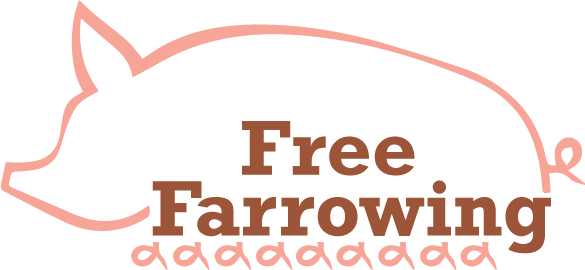Select a selection to explore the answer to important questions about understanding free farrowing.
- Why are there farrowing crates?
- What are the welfare issues with crates?
- Why is nest-building behaviour important?
- Can we keep piglets safe without crates?
Why are there farrowing crates?

The majority of sows are housed in farrowing crates from approximately five days before they are due to give birth until their piglets are weaned at approximately 28 days of age.
Why was the farrowing crate invented?
To reduce piglet mortality. The farrowing crate was first introduced in the 1960s and its main purpose was to lower the risk of piglets being crushed by the sow by controlling her movements, particularly when lying down.
What are the advantages of the farrowing crate?
In addition to reducing the risk of crushing, the farrowing crate has become the main form of maternity housing for pigs because it has the following advantages:
- Economical: compared to most indoor alternatives the farrowing crate is relatively economical
- Space Saving: a typical farrowing crate can fit into a floor footprint of only 3.6 square metres per sow and litter.
- Efficient: the farrowing crate allows efficient working conditions as they are usually built on fully or partially slatted floors facilitating relatively high levels of hygiene and minimal mucking out.
- Safe: as the sow is constrained to the dimensions of the crate (typically 2.2m x 0.50m) this affords relatively safe conditions for stockpeople, especially when having to handle piglets.
Farrowing crates are considered to be economical, efficient and safe with maximising piglet survival as a main aim. However, they raise serious welfare concerns, particularly for the sow.
What are the welfare issues with crates?

The farrowing crate predominantly raises welfare concerns for the sow, but there are also welfare issues for the piglets.
Piglet welfare issues
- Increased risk of stillbirth – although crushing risk is reduced in farrowing crates, there is evidence of increased risk of stillbirth.
- Increased risk of mis-mothering – there is evidence of increased incidences of savaging behaviour (particularly in primiparous sows)
- Lack of enrichment opportunities – the crates are commonly built on fully or partially slatted floors which prevent provision of some enrichment materials
Sow welfare issues
- Physical restriction – the crate limits the sow’s movements and prevents her from turning around
- Behavioural restriction via restraint – the crate prevents adequate expression of genetically programmed behaviours including mother-young interactions and nest-building behaviour
- Behavioural restriction via inadequate provision of nest-building substrate as crates are commonly built on fully or partially slatted floors
Nest-building behaviour is one of the most important behaviours that an expectant sow needs to perform.
Why is nest-building behaviour important?
- It is a highly motivated behavioural need
- It affects maternal hormones and prepares the sow for farrowing
- It can influence her maternal behaviour

Nest-building behaviour is a well researched and well documented behavioural pattern in pigs. It has been unaltered by domestication and no matter what environment a sow is kept in she will try to perform nest-building behaviour before giving birth to her piglets. It is considered a functional behaviour (i.e. it has a purpose).
In indoor systems the sow may not need to provide a protective nest for her piglets but she still wants to build one. Play the video showing nest-building behaviour of domestic sows in an outdoor farrowing environment and a conventional farrowing crate environment.
What is the purpose of nest-building?
The act of building a nest prepares the sow for farrowing. The more active and satisfying the nest-building phase the more calm and relaxed the farrowing phase. A calm farrowing phase is vital to promote piglet survival. If the sow is calm she will lie with her udder exposed and allow the piglets safe access to drink colostrum.
What does a sow need to nest-build?
The sow will start nest-building behaviour approximately 16-24h before farrowing. She performs very specific patterns of behaviour: increasing her restlessness and activity levels, carrying substrate to a preferred area (i.e. nest-site), digging and rooting that site to create a hollow and then manipulating and arranging the substrate. To do this behaviour she needs certain things from her environment:
- to increase her activity levels and “seek” a separate nest-site
- to turn-around and create the nest
Substrate
- to perform manipulation of nesting materials and get a sense of nest completion
Enclosure
- to be able to withdraw from the herd and isolate herself
- to give the nest-site a sense of protection
Suitable Flooring
- to keep substrate in the nest
The farrowing crate does not and cannot satisfy the behavioural needs of the sow. Restriction and in particular not being able to turn around during this time is the largest welfare detriment for the sow. To read more about the research conducted on the welfare issues of farrowing crates please visit our research page.
Well designed free farrowing systems where the sow can be kept loose can satisfy many of the sow’s behavioural needs. However, it is very important to remember the principal reason the farrowing crate was introduced – to protect piglets.
Can we keep piglets safe without crates?

Producer concerns
Producers have valid concerns about piglet survival. Modern sows range in weight with some of the hyper-prolific breeds reaching 300+kg. They give birth to multiple piglets weighing, on average 1-2kg each. Piglets are vulnerable when they are first born. They can suffer easily from chilling if they do not get to the udder and drink colostrum quickly. If the sow does not control her posture changes carefully she is at risk of crushing her piglets.
How do we keep piglets safe without restraining the sow?
There are successful systems in operation that have demonstrated the same production figures as farrowing crate systems. Successful systems consider design details that promote good maternal behaviour and features that can protect the piglets without restraining the sow. Included in those features can be those that allow staff to provide good management to maximise piglet survival.
Promote Good Maternal Behaviour
Sows that are calm, displaying careful posture changes and allowing safe access to the udder are good mothers.
- Provide design features that stimulate good maternal behaviour – to learn about this visit our research pages on design criteria and our specific pen features for best practices recommendations for providing these criteria.
- Select for good maternal behaviour – there is evidence that maternal behaviour traits are heritable. To learn more visit the research page.
- Develop good human-animal relationships – the stockperson can influence maternal behaviour. Find out best practice recommendations on free farrowing husbandry.
Piglet Protection Features
There are piglet protection features that can promote piglet survival without restraining the sow.
- Consider adopting a free farrowing system that provides features that protect the piglet and allow the stockperson to perform best practice protocols for maximising piglet survival. To learn about the different options and their key features visit farrowing systems.
- Install piglet protection features. For recommendations on this view piglet protection.

